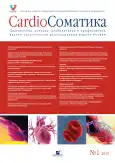Current approaches to rehabilitation of patients with chronic heart failure
- 作者: Arutyunov G.P1, Kolesnikova E.A1, Rylova A.K1
-
隶属关系:
- N.I. Pirogov Russian State Medical University
- 期: 卷 1, 编号 1 (2010)
- 页面: 20-24
- 栏目: Articles
- URL: https://journals.rcsi.science/2221-7185/article/view/44955
- DOI: https://doi.org/10.26442/CS44955
- ID: 44955
如何引用文章
全文:
详细
作者简介
G. Arutyunov
N.I. Pirogov Russian State Medical Universityд-р мед. наук, проф., проректор по научной и лечебной работе РГМУ им. Н.И. Пирогова, зав. каф. терапии Московского факультета РГМУ им. Н.И. Пирогова
E. Kolesnikova
N.I. Pirogov Russian State Medical Universityканд. мед. наук, ассистент каф. терапии Московского факультета РГМУ им Н.И. Пирогова
A. Rylova
N.I. Pirogov Russian State Medical Universityд-р мед. наук, проф. каф. терапии Московского факультета РГМУ им Н.И. Пирогова
参考
- Braunwald E. The Management of Heart Failure. Circulation: Heart Failure 2008; 1: 58–62.
- Braunwald E. Heart failure. In: Wintrobe M.M., Thorn G.W., Adams R.D., Bennett I.L. Jr, Braunwald E, Isselbacher K.J., Petersdorf R.G., eds. Harrison’s Principles of Internal Medicine. 6th ed. New York, NY: McGraw Hill, 1970; p. 1132–41.
- Braunwald E. Heart failure and cor pulmonale. In: Kasper D.L., Braunwald E, Fauci A.S., Hauser S.L., Longo D.L., Jameson J.L., eds. Harrison's Principles of Internal Medicine. 16th ed. New York, NY: McGraw Hill, 2005; p. 1367–78.
- Susan J. Pressler, Irmina Gradus-Pizlo, Suzanne D. Chubinski, George Smith, Susanne Wheeler, Jingwei Wu and Rebecca Sloan.Family Caregiver Outcomes in Heart Failure. Am J Crit Care 2009; 18: 149–159 doi: 10.4037/ajcc2009300.
- Агеев Ф.Т., Даниелян М.О., Мареев В.Ю. и др. Больные с хронической сердечной недостаточностью в российской амбулаторной практике: особенности контингента, диагностики и лечения (по материалам исследования ЭПОХА-О-ХСН). Сердеч. недостат. 2004; 5(1): 4–7.
- Даниелян М.О. Прогноз и лечение хронической сердечной недостаточности (данные 20-летнего наблюдения). Автореф. дис.. канд. мед.наук. М., 2001.
- Buller N.P., Jones D.A., Poole-Wilson P.A. Direct measurement of skeletal muscle fatique in patient with chronic heart failure. Br Heart J 1991; 65: 20–4.
- Drexler H et al. Expression, activity and functional significance of inducible nitric oxide synthase in the failing human heart. J Am Coll Cardiol 1998; 32, 955–63.
- Lipkin D, Jones D, Round J, Poole-Wilson P. Abnormalities of skeletal muscle in patients with chronic heart failure. Int J Cardiol 1988; 18: 187–95.
- Mancini D, Davis L, Wexler J et al. Dependence of enhanced maximal exercise performance on increased peak skeletal muscle perfusion during long - term captopril therapy in heart failure. J Am Coll Cardiol 1987; 10: 845–50.
- Mancini D.M., Coyle E, Coggan A et al. Contribution of intrinsic skeletal muscle changes to 31P NMR skeletal muscle metabolic abnormalities in patients with heart failure. Circulation 1989; 80: 1338–46.
- Mancini D.M., Henson D, La Manca J et al. Benefit of selective respiratory muscle training on exercise capacity in patients with chronic congestive heart failure. Circulation 1995; 91 (2): 320–9.
- Sullivan M.J., Higginbotham M.B., Cobb F.R. Exercise training in patients with chronic heart failure delays ventilatory anaerobic threshold and improves submaximal exercise performance. Circulation 1989; 79: 324–9.
- Massie B, Conway M, Rajagopalan B et al. Skeletal muscle metabolism during exercise under ischemic conditions in congestive heart failure: evidence for abnormalities unrelated to blood flow. Circulation 1988; 78: 320–6.
- Weiner D.H., Fink L.I., Maris J et al. Abnormal skeletal muscle bioenergetics during exercise in patients with heart failure: role of reduced muscle blood flow. Circulation 1986; 73: 1127–36.
- Wilson J.R., Fink L, Maris J et al. Evaluation of energy metabolism in skeletal muscle of patients with heart failure with gated phosphorus-31 nuclear magnetic resonance. Circulation 1985; 71: 57–62.
- DeTroyer A, Estenne M, Yernault J. Disturbance of respiratory muscle function in patients with mitral valve disease. Am J Med 1980; 690: 867–73.
- Hammond M, Bauer K, Sharp J, Rocha R. Respiratory muscle strength in congestive heart failure. Chest 1990; 98: 1091–4.
- Madariaga V.B., Iturri J.B., Manterola A.G. et al. Comparison of 2 methods for inspiratory muscle training in patients with chronic obstructive pulmonary disease. Arch Bronconeumol 2007; 43 (8): 431–8.
- Mancini D, Nazzaro D, Ferraro N et al. Demonstration of respiratory muscle deoxygenation during exercise in patients with heart failure. J Am Coll Cardiol 1991; 18: 492–8.
- Padula C.A., Yeaw E. Inspiratory muscle training: integrative review. Res Theory Nurs Pract 2006; 20 (4): 291–04.
- Geddes E.L., O'Brien K, Reid W.D. et al. Inspiratory muscle training in adults with chronic obstructive pulmonary disease: an update of a systematic review. Respir Med 2008; 102 (12): 1715–29.
- Ramirez-Sarmiento A, Orozco-Levi M, Guell R et al. Inspiratory muscle training in patients with chronic obstructive pulmonary disease: structural adaptation and physiologic outcomes. Am J Respir Crit Care Med 2002; 166 (11): 1491–7.
- Weiner D.H., Fink L.I., Maris J et al. Abnormal skeletal muscle bioenergetics during exercise in patients with heart failure: role of reduced muscle blood flow. Circulation 1986; 73: 1127–36.
- Gaspar R. Chiappa, Bruno T. Roseguini, Paulo J.C. Vieira et al. Inspiratory Muscle Training Improves Blood Flow to Resting and Exercising Limbs in Patients With Chronic Heart Failure. J Am Coll Cardiol 2008; 51: 1663–71.
- Laoutaris I.D., Dritsas A, Adamopoulos S et al. Effects of inspiratory muscle training in patients with chronic heart failure. J Am Coll Cardiol 2008; 52 (23): 1888–9.
- Hulzebos E.H.J., Helders P.J.M., Favie N.J. et al. Preoperative Intensive Inspiratory Muscle Training to Prevent Postoperative Pulmonary Complications in High-Risk Patients Undergoing CABG Surgery. JAMA 2006; 296: 1851–7.
- Колесникова Е.А. Эффективность тренировок дыхательной мускулатуры в комплексной терапии больных инфарктом миокарда в остром периоде и на различных этапах реабилитации. Автореф. дис.. канд. мед. наук. М., 2009.
- http: //www.controlledtrials.com/mrct/trial/439115/
- Michalsen A, Kцnig G, Thime W. Preventable causative factors leading to hospital admission with decompensated heart failure. Heart 1998; 80: 437–41.
- Евзерихина А.В. Клиническая эффективность различных форм непрерывного образования пациентов, страдающих ХСН. Автореф. дис.. канд. мед. наук. М., 2009.
- Development and implementation of a comprehensive heart failure practice guideline. Heart Failure Soc Am J Card Fail 2006; 12 (1): e3–9.
补充文件







